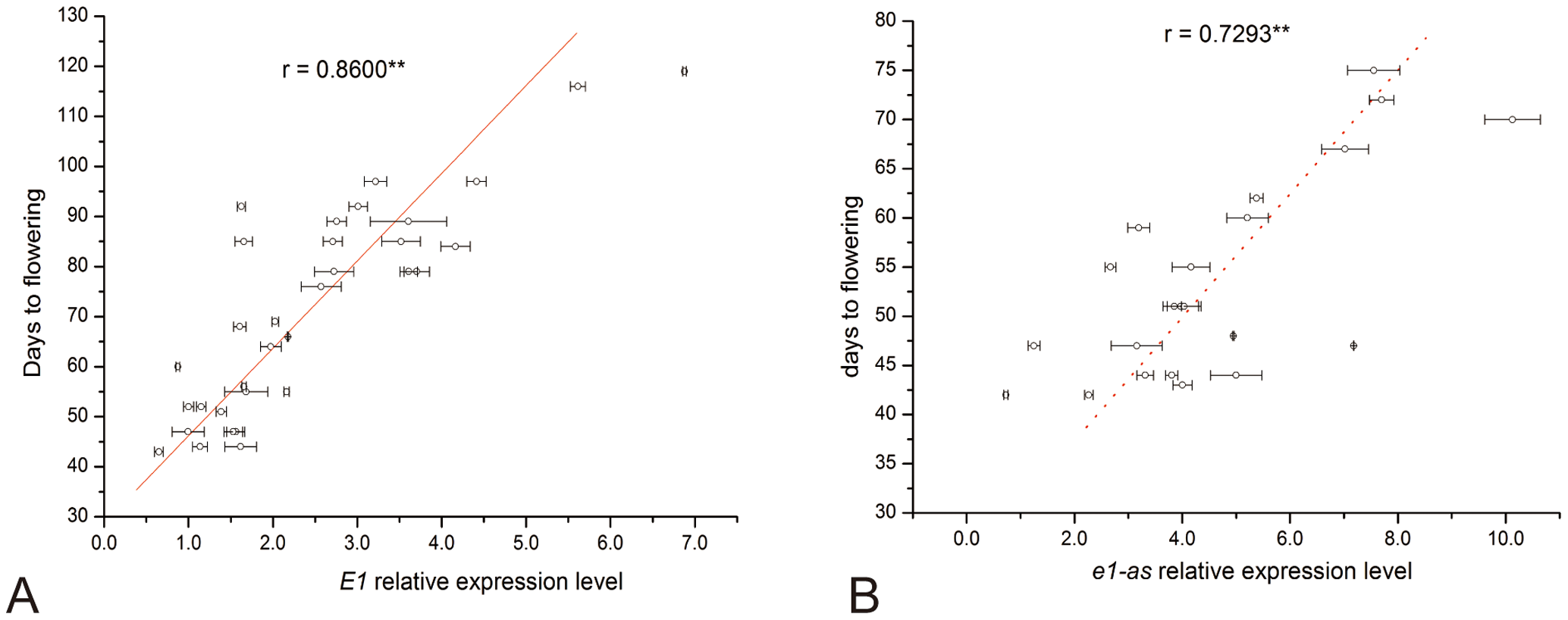PLOS ONE:东北地理所鉴定大豆的4个主要发育期基因的表型
中国科学院东北地理与农业生态研究所大豆分子育种重点实验室对E1、E2、E3及E4这四个主要生育期基因进行了基因型鉴定,发现不同品种中E1基因的表达量与大豆开花期呈极显著相关。相关文章发表于2014年5月15日的《PLoS ONE》杂志上。

E1(e1-as)基因的表达量与大豆品种开花期间的相关分析
中国科学院东北地理与农业生态研究所大豆分子育种重点实验室在成功地完成了大豆生育期基因E1、E2、E3及E4基因克隆的基础上,选择了180个具有代表性的大豆品种,同时在全国主要大豆生态区的六个试点对大豆的开花期(R1)与成熟期(R7或R8)进行了表型观察,对四个主要生育期基因进行了基因型鉴定,其中E1、E2、E3与E4基因的隐性基因型比率分别为38.34%、84.45%、36.33%和7.20%。将我国大豆品种划分为8个基因型类型,e1-nf、e1-asE4、E1-asE3E4、e1-asE2(E3)E4、E1、E1E4(E3)、E1E3E4和E1E2E3E4,其中E1E3E4为优势基因型,占26.1%,e1-nf型(E1功能缺失型)开花最早,而E1E2E3E4 基因型开花最晚。
并且在研究中发现不同品种中E1基因的表达量与大豆开花期呈极显著相关,说明大豆许多已知或未知的开花位点可能通过调控E1基因来控制开花。该研究为进行深入研究大豆调控开花的基因网络及开展分子育种提供重要基础资料。
在夏正俊研究员的指导下,助理研究员翟红与博士研究生吕世翔为文章的共同第一作者,研究成果在线发表于PLOS ONE 。该研究得到了中国科学院知识创新工程重要方向性项目 (Grant KZCX2-EW-303)、先导项目(XDA08010105)及百人计划等项目的资助。
原文摘要:
Hong Zhai, Shixiang Lü, Yueqiang Wang, Xin Chen, Haixiang Ren, Jiayin Yang, Wen Cheng, Chunmei Zong, Heping Gu, Hongmei Qiu,Hongyan Wu, Xingzheng Zhang, Tingting Cui, Zhengjun Xia
The time to flowering and maturity are ecologically and agronomically important traits for soybean landrace and cultivar adaptation. As a typical short-day crop, long day conditions in the high-latitude regions require soybean cultivars with photoperiod insensitivity that can mature before frost. Although the molecular basis of four major E loci (E1 to E4) have been deciphered, it is not quite clear whether, or to what degree, genetic variation and the expression level of the four E genes are associated with the time to flowering and maturity of soybean cultivars. In this study, we genotyped 180 cultivars at E1 to E4 genes, meanwhile, the time to flowering and maturity of those cultivars were investigated at six geographic locations in China from 2011 to 2012 and further confirmed in 2013. The percentages of recessive alleles at E1, E2, E3 and E4loci were 38.34%, 84.45%, 36.33%, and 7.20%, respectively. Statistical analysis showed that allelic variations at each of four loci had a significant effect on flowering time as well as maturity. We classified the 180 cultivars into eight genotypic groups based on allelic variations of the four major E loci. The genetic group of e1-nf representing dysfunctional alleles at the E1locus flowered earliest in all the geographic locations. In contrast, cultivars in the E1E2E3E4 group originated from the southern areas flowered very late or did not flower before frost at high latitude locations. The transcriptional abundance of functional E1 gene was significantly associated with flowering time. However, the ranges of time to flowering and maturity were quite large within some genotypic groups, implying the presence of some other unknown genetic factors that are involved in control of flowering time or maturity. Known genes (e.g. E3 and E4) and other unknown factors may function, at least partially, through regulation of the expression of the E1 gene.
作者:中科院

